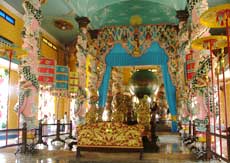Cao Dai Great Temple is located in Hoa Thanh District, 5km southeast of Tay Ninh Town, Tay Ninh Province. About 95 kilometers from the center of HCMC, Seeking tranquility in Cao Dai Temple Cao Dai Great Temple is a suitable place for those who need a break, physically, mentally and spiritually from the crowd and busy of city.
 Cao Dai Great Temple is a magnificent architectural construction with 12 doors and a great surrounding wall. The compound includes a green park and two primitive forests. Built in 1933, the temple honors not only Cao Dai religion but also Taoism, Buddhism, Confucianism, Christianity and Islam.
Cao Dai Great Temple is a magnificent architectural construction with 12 doors and a great surrounding wall. The compound includes a green park and two primitive forests. Built in 1933, the temple honors not only Cao Dai religion but also Taoism, Buddhism, Confucianism, Christianity and Islam.
The Great Temple is 140m long and 40m wide. It has 4 towers each with a different name: Tam Dai, Hiep Thien Dai, Cuu Trung Dai, and Bat Quai Dai. The interior of the temple consists of a colonnaded hall and a sanctuary. The 2 rows of columns are decorated with dragons and are coated in white, red, and blue paint. The domed ceiling is divided into 9 parts similar to a night sky full of stars and symbolizing heaven. Under the dome is a giant star-speckled blue globe on which is painted the Divine Eye, the official symbol of Caodaism.
As the sect’s main headquarters, males must enter on the right and females on the left and shoes have to be removed before entering the massive main hall. From the bustle, heat and dust of the outside world, the Temple provides a sense of calm, peace and light.
Upon entering the temple, tourists will see serene white-robed persons mingling with the visitors and attending to offerings. They do not seem to feel invaded and happily answer inane questions.
Another impression is the Divine Eye encased in a triangle. This is a recurring motif on both walls and ceilings. The sacred inner nave is guarded by gaudy pink pillars intertwined with snarling green dragons complete with elongated red tongues.
After examining the extraordinary murals and central altar, which is heavenly adorned with fruit, flowers and, curiously, statues of storks, it’s time to observe the ceremonies.
Before joining a ceremony, tourists are led up a narrow stairwell behind the main balcony. A small string band accompanies the dozens of upwardly moving feet with weird and wonderful music. The balcony, which runs the entire length of the cathedral, holds a frightening number of inquisitive on-lookers who all peer down on the proceedings. There is a hushed silence and an air of growing anticipation. Tourists will see Cao Dai worshippers spill out from annexes below, adorned in either white, red, blue or yellow flowing robes, signifying the Buddhist, Taoist and Confucian elements.
The sound of gongs accompanies them as they take their positions on the vast floor space below. Rows and rows of gracefully attired worshippers kneel down before the elevated altar. Gongs beat time with the string instruments and harmonious voices chant as in a surreal dream.
One of the murals depicts such disciples as French poet, playwright, and novelist Victor Hugo (apparently highly praised as a busy intermediary spirit) and Chinese Nationalist Leader Sun Yat Sen. Monkeys and many kinds of seasoned trees help make the experience even more pleasant.
Every year, the temple welcomes ten thousands of pilgrims who come to attend the two main festivals on the 8th of the fist lunar month and the 15th of the eight lunar month. At each festival of the year, the temple is animated with flows of pilgrims, lion, dragon, phoenix and turtle dances and colorful disguising festivities, parades and boat trips.
Phuong Anh (Edited)